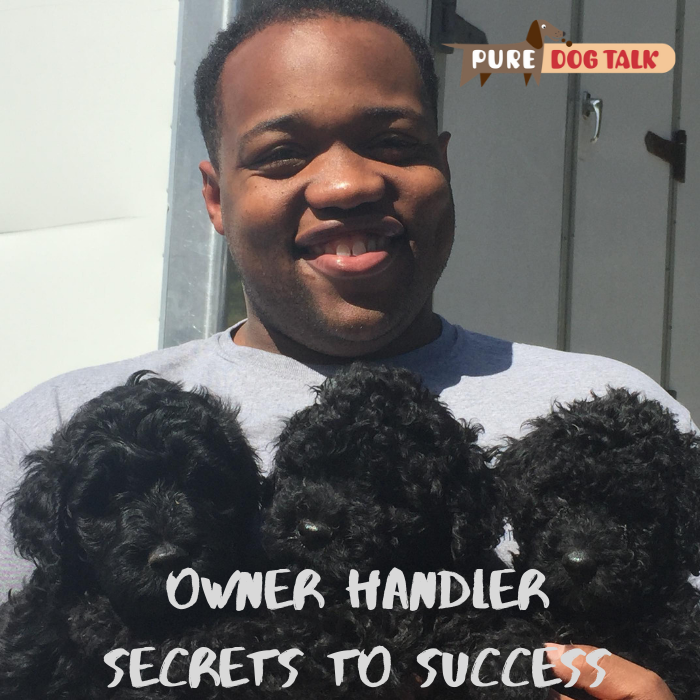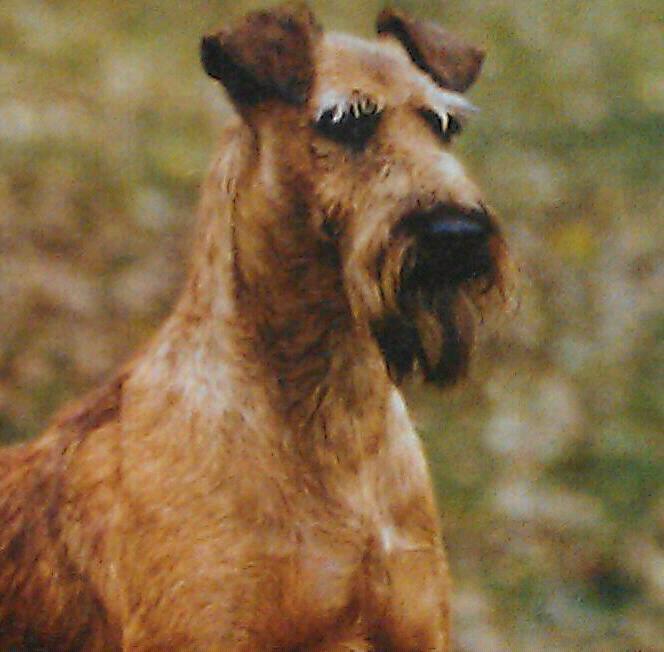Posts by Laura Reeves
325 – Dog Judging, Rumors and Reality Checks
Dog Judging, Rumors and Reality Checks
AKC judge Lee Whittier, founder of Dog Show Mentor and a former AKC Field Rep, and host Laura Reeves talk turkey about judging, judges, the process and the results.
Some of the key take-aways from the conversation:
- Judges are not all created equal. Some ARE better than others.
- Judges WANT and TRY to do a good job.
- Judges spend a LOT of time, money and grief to earn the honor of presiding from the center of the ring. Check out the YouTube video of the PureDogTalk Friday Night Forum panel discussion. Current AKC Executive Field Representative Bryan Martin, and AKC judges Brian Meyer and Sylvie McGee share a TON of information about the process of becoming an AKC approved judge.
- What a judge sees in the center of the ring is often WAY different than what you see outside the ring. When you see a dog week in and week out, the accumulated knowledge may, in some cases, create a different picture than what the judge has during his/her 2 minutes in the ring.
- Judges are NOT hatched from an egg! I say this all the time at the panel discussions. I think exhibitors forget this part. All judges started at basically the same place you are today. They showed dogs, they bred dogs, they schlepped the gear and scooped the poop, they drove the miles and slept in the sketchy hotel rooms. Every single judge in the ring has been there, done that and most likely a whole lot more.
- Lee and I agree that we risk accusations of being a bit Pollyanna and acknowledge that bad apples exist, but that we, the exhibitors, should not allow them to spoil the whole basket.
- Exhibitors will get the most enjoyment from their dog show experiences if they choose a positive social group, do a little research about their judges and try not to get wrapped up in the rumor-mongering when it happens.
Make sure you download and listen to the episode for more “inside insights”
324 – Veterinary Voice: Allergies! Food, Inhalant, Fleas & More
Veterinary Voice: Allergies! Food, Inhalant, Fleas & More
Food allergies are not as common as people believe, according to veterinarian Marty Greer. Inhalant, contact and flea allergies are more prevalent. Food allergy is mostly associated with chronic ear infections and recurrent skin problems. Conclusive diagnosis requires tedious food elimination diets.
“Fall is a terrible time for allergies,” Greer noted. “Especially inhalant allergies and contact allergies of pollen in the grass. You can wash the dog’s feet at night to help reduce symptoms.”
Foot chewing is the top symptom for inhalant/contact allergy, Greer said. She also observed that allergies can also be additive. A dog may have a food allergy that is only triggered by the addition of a seasonal contact allergy, for example.
It only takes one!
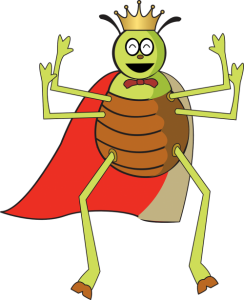 Flea allergy is signaled by dogs that are itchy around the rump, Greer noted. She added that one flea bite is all it may take to set off an allergic response.
Flea allergy is signaled by dogs that are itchy around the rump, Greer noted. She added that one flea bite is all it may take to set off an allergic response.
“Flea control products today are really good. Topical or oral, they are very effective. Vacuuming regularly is an important control system for fleas,” Greer said.
Newer flea/tick control products affect the nervous system of only the parasite, Greer said. Older organophosphate-based products were not as good, she added.
Pro/Con of flea/tick preventatives
Oral meds are not recommended for patients with a history of seizures, Greer said. “They are not going to make a normal dog have a seizure. But they could trigger seizure sensitive dogs. Bravecto is the only oral medication labeled for breeding dogs,” she added.
Advantages to the oral preventatives are that they leave no residue on coat, Greer said. The advantages of topical treatments is they are not a concern in seizure sensitive patients and they make a repellant shield to biting insects. Topicals also get rid of fleas/ticks more quickly.
Anti inflammatory treatments
“In the last 10-15 years, new products have come on the market to help to replace long-term steroid use,” Greer said. “Short course steroid use is effective and the side effects are minimal.”
Links and information from Dr. Greer to learn more:
- Atopica https://www.elanco.us/products-services/dogs/atopica-cyclosporine-capsules-usp-modified Dog Quiz: https://us.atopica.com/survey-dog , Cat Quiz: https://us.atopica.com/survey-cat
- Apoquel https://www.zoetisus.com/products/dogs/apoquel/index.aspx
- Cytopoint https://www.zoetisus.com/products/dogs/cytopoint/the-itch-cycle.aspx
- Do not use APOQUEL in dogs less than 12 months of age or those with serious infections. APOQUEL may increase the chances of developing serious infections, and may cause existing parasitic skin infestations or pre-existing cancers to get worse. APOQUEL has not been tested in dogs receiving some medications including some commonly used to treat skin conditions such as corticosteroids and cyclosporine. Do not use in breeding, pregnant, or lactating dogs. Most common side effects are vomiting and diarrhea. APOQUEL has been used safely with many common medications including parasiticides, antibiotics and vaccines
- CYTOPOINT is a monoclonal antibody (mAb)* treatment for dogs that specifically targets and neutralizes canine IL-31,† an important cytokine‡ involved in sending the itch signal to the brain in chronic atopic dermatitis2
- Because it is highly targeted to a specific cytokine involved in canine atopic dermatitis, CYTOPOINT has minimal impact on normal immune functions3
- CYTOPOINT is eliminated via normal protein degradation pathways in the same way as naturally occurring antibodies; metabolism does not involve the liver or kidneys
323 – Marketing Strategy Ensures Viability of Endangered Breed
Marketing Strategy Ensures Viability of Endangered Breed

Dandie Dinmont Terrier
Jody Moxham is a Dandie Dinmont Terrier fancier and a globally successful marketing professional. She was asked by her club to create an ad for the breed. She refused. And created far more than just an “ad.”
DDTCA created the Strategic advisory committee, which Moxham chairs, exclusively dedicated to ensuring the long-term viability of the Dandie Dinmont Terrier.
Surging numbers
In three years, the work of the committee has increased registrations of the breed by more than 150 percent. Membership in the club is surging to the point it can’t keep up with printing the membership roster, Moxham noted. According to AKC statistics, the breed has risen six points in popularity after years of decline.
“I asked myself, ‘How would best marketers address this.’ There is a thing called the product life cycle in marketing,” Moxham said. “A lot of breeds are in the “decline” phase…. Marketers reposition a “product” and put it back in to introductory stage. That’s what we’re doing.
Product marketing techniques
“I created a methodology for forecasting success of marketing communications while they were just ideas on paper. We marketed it to multi-national corporations and helped them strengthen the persuasiveness of their strategies and their communications. We were proven effective in 40-some countries, according to the tough measures marketers use. A month after 9/11, the US Government called and asked if we would be willing to see if the methodology that worked so well in the commercial world could also work for national security interests. We gained contracts from across all arms of the USG – Defense, Military, Intelligence, and State.
“It has been a fascinating journey. What drives me is making a difference. I thrive on doing things that have never been done before. Or that are super tough. Easy can be done by anyone. Really hard piques my interest.
“We will not stay vulnerable”

Betty-Anne Stenmark and Jody Moxham bred Dandie Dinmont Terriers together for many years.
“That is the background that I brought to tackling the objective of ensuring the viability of the Dandie Dinmont Terrier for generations to come. You probably know we are a highly vulnerable breed. But we will not stay vulnerable.
“We started this program three years ago and formed the Strategic Advisory Committee as an action arm of the DDTCA.
“The first of four surveys has been released, each dealing with a specific area of breeding and raising healthy litters. Collectively they will be the foundation for mentoring programs for DDTCA and other breed clubs that want to use our findings. We want the DDTCA to be known as the innovator of support programs for breeders … and as a sponsor of best breeding practices.”
To learn more about the DDTCA visit: https://www.ddtca.org/
To hear the conversation with legendary Master Breeder Betty-Anne Stenmark about the Dandie Dinmont Terrier and its “gene puddle,” click to listen here.
322 – The Winning Edge! Panel Discussion With the Masters
The Winning Edge! Panel Discussion With the Masters
Host Laura Reeves moderates a Friday Night Forum Panel Discussion on the topic of the “Winning Edge” with Judges Rick Gschwender and Pluis Davern and Professional Handler Bill McFadden.
It is not the judge’s job to find a “diamond in the rough,” Reeves posits. “Polish your “gem stone” for your best chance of success.”
Good habits
 Gschwender starts the discussion by asking the audience about their habits with the dogs they exhibit.
Gschwender starts the discussion by asking the audience about their habits with the dogs they exhibit.
“How many of you train your dog? Road work him? Take video to see what the judge sees? Clean their teeth?” Gschwender queried. “I see people all the time, they’re paying $30 to enter the dog and haven’t even cleaned teeth.”
Gschwender adds, “Watch the judges. If you pay attention, you will see consistency in what they put up. You might not like it, but you will figure out what I like and come back and show that to me.”
Motivated by motion
Davern noted, in a fascinating observation, that people are *predators.* Which means “we are motivated by motion. What are judges looking at?” Davern asked rhetorically. “Motion. It catches the eye. You can *subtly* move your hand to show a pretty head, for example.
“You’re in the ring, you’re all showing the same “product.” There’s 20 boxes of cornflakes. What makes yours better than the others?”
Owner handlers have a huge advantage, Davern said. They are spending time with the dog they love.
“This is a great sport! Nobody takes a golf club to bed at night,” Davern said. “Life is not all about winning.”
Be prepared
“Take a deep breath and don’t rush,” McFadden advises. He also notes that in some cases, owner handlers who are long time breeders are “experts showing to novices.” Judges are life-long learners and may be new to a breed. “Present your breed the way it should be shown.”
 Most importantly, McFadden said, be prepared. “Make sure your dog is in condition, physically, mentally, emotionally.”
Most importantly, McFadden said, be prepared. “Make sure your dog is in condition, physically, mentally, emotionally.”
“You’ll have successes and failures you deserve and ones you don’t. It happens to handlers too. We show 20 dogs and might win with two,” McFadden added.
For more insight from a couple of these panelists, you can listen back to:
https://puredogtalk.com/10-bill-and-taffe-mcfadden-live-at-akc-nationals-wisdom-wednesday-2/
https://puredogtalk.com/34-sussex-spaniels-hunt-tests-search-and-rescue-pluis-davern-tells-all-2/
https://puredogtalk.com/35-dogs-to-the-rescue-firefighters-first-responders-and-pluis-davern-2/
321 — Tricks Are for Show Dogs! Improve Focus in the Ring
Tricks Are for Show Dogs! Improve Focus in the Ring
Show Dog Prep School founder, Vicki Ronchette, provides tips for training tricks to show dogs to help them focus and have fun.
“Training tricks is fun,” Ronchette said. “People and dogs enjoy it more than they do training traditional exercises. It is relaxing. And it’s a good way for people to improve their mechanical training skills.”
Dogs get bored in the ring, Ronchette noted. Having a repertoire of tricks available helps dogs and exhibitors relax, she said.
Bonus, the dogs and handlers having fun makes a good impression on audience and serve as crowd pleasers. Note the phenomenal success of the “sit up” by the Sussex Spaniel, Bean, at the 2018 Westminster Kennel Club show.
Ronchette shared a few of her favorite “tricks” to teach clients that provide specific benefits to dogs and their performance.
Touch!
Target training is a favorite of Ronchette’s. She trains the dog to touch its nose to her hand.
“It’s so beneficial,” Ronchette said. “It’s easy to teach. And when you have a distracted dog, it gets their attention.”
Sit Pretty
Sit up and beg can be a controversial trick, as some feel it can be harmful to the dog’s back. Other trainers argue it is indispensable core conditioning that strengthens back muscles. Either way, that super cute “begging” for attention is a sure fire winner.
Get on top
Teaching the dog to get up on a big rock, grooming table or other high perch, Ronchette says, is a great confidence builder. “They need to own these behaviors,” she noted.
AKC’s Trick Dog program allows owners to put a fun title on the end of the dog’s name, Ronchette noted, helping them “get their feet wet in something other than conformation.”
To learn more about the origins of the Trick Dog program, take a listen to my interview with AKC’s Doug Ljungren, the program’s biggest advocate.
128|Doug Ljungren is Up to Tricks…Trick Dogs|AKC VP of Sports and Performance|Pure Dog Talk
320 – You ARE What You Eat and So is Your Dog
You ARE What You Eat and So is Your Dog
Dr. Diane Brown, CEO of the AKC Canine Health Foundation, joins us again to talk about fascinating new research on the “gut-brain axis.” In other words, the microscopic bugs inside the dog’s body are being proven to interact with what’s going on in its brain.
From the CHF Newsletter: “The adage “you are what you eat” may be more profound than we ever realized. A growing body of evidence shows a complex system of two-way communication between the gastrointestinal (GI) tract and neurologic system in humans and dogs. The link between GI health and diseases such as multiple sclerosis, autism, and epilepsy has been studied in humans. In fact, patients with celiac disease or inflammatory bowel disease have an increased risk of developing epilepsy. Since the community of microorganisms that live in the digestive tract – known as the gut microbiome – plays an important role in GI health, what impact does it have on neurologic disease? AKC Canine Health Foundation (CHF) funded researchers are exploring the role of this microbiomegut-brain axis in canine epilepsy.”
http://www.akcchf.org/educational-resources/library/articles/AKC-CHF-Discoveries-Summer-2019.pdf
Gut microbiome
“The bacteria that live in the gut have been shown to have importance to both health and disease,” Brown said.
CHF research is determining what type of bugs normally live in the gut (literally any part of the digestive system from top to bottom). Which ones of those bugs are pathogens and which ones prevent disease is an enormous topic.
Many of us understand, for example, that antibiotics completely change the gut microbiome. But this new research is documenting associations with other disorders, including the impact of bacterial content in the gut and how it is influencing epilepsy and anxiety.
Using proprietary probiotics to manage post-antibiotic diarrhea is one thing. But Probiotics used over the course of six weeks are showing an impact on anxiety behaviors in dogs, providing a non-drug-based treatment for this frequent issue in all dogs.
Poop is cool!
Researchers speaking at a recent CHF conference even discussed using fecal transplants, delivered as an enema, to transplant healthy flora fecal material thereby improving the health of the dog.
319 — Cavalettis for Show Dogs with Vicki Ronchette
Cavalettis for Show Dogs with Vicki Ronchette
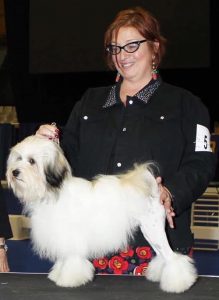
Vicki Ronchette with her Lowchen.
Show Dog Prep School founder Vicki Ronchette shares her tips and tools for using cavalettis to train body awareness, conditioning and more.
Cavalettis, Ronchette said, are useful for a variety of issues. Dogs who pace, forge on the leash, need to know where to put their feet amongst other topics are well served by practicing with caveletti training.
One of the most common uses is to build muscle memory to increase reach and extension, Ronchette said. “Most dogs love doing the cavalettis,” she added.
Using simple, inexpensive materials, Ronchette provides direction for building and utilizing these obstacles in an exhibitor’s “tool kit” of preparing the dogs for the show ring.
How To’s and Why For’s
One of Ronchette’s most frequently asked questions is how far apart to set the poles for proper gaiting. She said she measures from the front toe to the back toe when the dog is in a comfortable stack. That is the “elementary” distance the poles are placed apart. As the dog gains skill and confidence, the poles are moved further apart to make them the dog increase its stride.
“We’re asking these dogs to be athletes in the show ring,” Ronchette said. “It’s more than just walking around. It’s walking around and looking fabulous.”
One specific training opportunity Ronchette uses the obstacles for is to teach not to chase other dogs. “I make them concentrate on foot work instead of chasing,” she observed.
“I strongly believe that if there is any physical limitation the dog is aware of it and it increases anxiety,” Ronchette said. “When you do these type of exercises, the dog ‘owns’ that behavior and it creates confidence. Confidence changes a dog’s carriage.”
Ronchette’s course at Show Dog Prep School.
Canine Conditioning with Dixie Rae Sick.
318 – Owner Handler Secrets: Make a Plan and Be Consistent
Owner Handler Secrets to Success: Make a Plan and Be Consistent
Remy Smith-Lewis, breeder, owner, handler of Portugese Water Dogs, shares the secrets that took him to the top, winning his National Specialty as an owner handler.
Smith-Lewis said he did not come from a “dog” family. He was awestruck by his breed when the San Francisco Giants began using the dogs to retrieve balls that were hit over the fence.
He started as a junior handler, worked for professional handlers Sally George and Bill and Taffe McFadden. He showed his first big winner to multiple Best in Show awards and a national specialty win before turning over the dog’s career to the McFadden team to manage.
“I was at a place in my career that I really needed to decide what to do and focus on it,” said Smith-Lewis, who began his career at Google and now works for a new tech start up in the Bay Area.
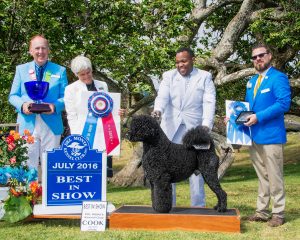
Remy Smith-Lewis handling his Portugese Water Dog to Best in Show at Del Monte Kennel Club under judge Pluis Davern.
His recommendation to owner handlers working a full-time job is, “You CAN do it!” But his secrets are: dedication, making sacrifices, having a plan, keeping on a schedule, and staying consistent.
Condition, Condition, Condition
Whether it is road work, coat work or trimming, competitive dogs MUST be in condition, Smith-Lewis noted. If that means skipping company happy hour in order to spend the extra time brushing, bathing, biking or trimming your dog, that’s what needs to happen.
“Complaining about handlers always winning is the easy way out,” Smith-Lewis said.
Owner handlers need to remember that dogs need routines, Smith-Lewis noted. The dog can’t always be on the couch. And the owner needs to find a mentor and *listen* to the mentor.
Smith-Lewis laughingly recalls a favorite admonition from one of his early mentors, Bill McFadden, “God gave you two ears and one mouth, use them wisely.”
“We need to break away on our own at some point,” Smith-Lewis said. “But a mentor’s job is to guide you back onto a good path when you get too far out of line.”
One final suggestion? “Join an all-breed club and work and learn,” Smith-Lewis said.
Want to hear more from Owner Handlers? Check out these past episodes:
57 – Best in Show: How an Owner-Handler Competes with the Pros – Tricia Stanczyk
25 – Patricia Trotter: Legendary Breeder, Author, and AKC Judge – Vin-Melca’s Norwegian Elkhounds
317 – New Resources for Purebred Dog Enthusiasts
New Resources for Purebred Dog Enthusiasts
Host Laura Reeves visits with two exhibitors, Cara Ryckman and Michelle Conroy, who have each taken huge steps to create resources to benefit purebred dogs and their people. These three 50something women with passion, dedication and a desire to “*do* something, not just complain” encompass close to 120 years of combined experience in purebred dogs.
Both Ryckman and Conroy saw voids in the world of purebred dogs and created ingenious ways to fill them. Spending their own time and resources, they have created a brand new social media ap (Ryckman) and a certification of breeders/rescues for the general public’s use (Conroy).
Cara Ryckman – Social media gone to the dogs
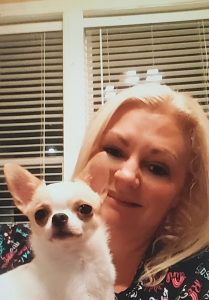
Cara Ryckman with her heart dog, GCH-S CH Hi-C Chanel Pearls and Ice at Terlingua.
“Dogs are our life!
This page and our site brought to you by Cara Ryckman of Terlingua Chihuahuas. I strive to create a friendly, positive, free social experience for people who love purebred dogs!
This site was created as a positive step in uniting the dog fancy and the general public in the hopes of preserving our heritage breeds for the future and bringing awareness to the predictability and dependability of purposefully-bred dogs and the fun of the purebred dog world. All are welcome!”
Michelle Conroy – Applying a lifetime of knowledge to certify breeders
“After more than 30 years working with animals, we have seen a lot and we haven’t always liked what we saw. Bad breeding practices and low-quality rescue operations are gaining ground. Many buyers and adopters hold negative views of breeders, and that’s largely due to a lack of quality control across the industry.
Here’s the truth: There are many quality breeders and fantastic rescues out there.
The problem is that it’s almost impossible for buyers and adopters to identify them. From mountains of misinformation to practically zero credible resources for finding ethical breeders or rescues, the public struggles to figure out what’s what.
We think it’s time for that to stop.”
https://breedercertification.org/
Listen now to hear their stories. Then check out these amazing new resources. Join Laura in her ongoing initiative to build up and showcase other innovative folks in the sport. You, too, can support MORE dog people helping dog people.
Listen to our previous episodes with OTHER great resources.
79 – Valerie Nunes-Atkinson Handling Seminars: Ready to Handle Like a Pro?
60 – National Purebred Dog Day: Susi Szeremy
91 – Dog Show Grooming, Poodle University, Online Handling and Allison Foley
201 – Exhibitor Education Courses Come Online | Pure Dog Talk
316 — Ireland’s “Heritage Status” for Native Dog Breeds
Ireland Designates “Heritage Status” for Native Dog Breeds
Sean Delmar, president of the Irish Kennel Club and Kerry Blue Terrier breeder, has just achieved the holy grail of “heritage status” for the nine native Irish breeds.
Heritage Status
JULY 16, 2019
I am pleased to announce that the 9 Irish Breeds have been granted National Heritage status by the Minister.
This is a wonderful step in the future protection and development of our amazing Irish Breeds and comes after many years of representations by those committed to Irish Breeds.
On behalf of The Irish Kennel Club I would like to specifically acknowledge the commitment of the following who put there heart and soul into making this a reality. Cathy Delmar, Eddie Burke, Vincent Flannelly.
Sean Delmar, President
“I thought there was a chance these breeds could go out of existence,” Delmar said. “I thought the Government should take some responsibility. We wanted to convince them these dog breeds are part of the patchwork quilt of the Irish people.”
This exciting success required a lot of initiatives over 10 years, Delmar noted. The small group of folks involved did demonstrations, paraded dogs at schools, had dogs on “chat shows” on TV.
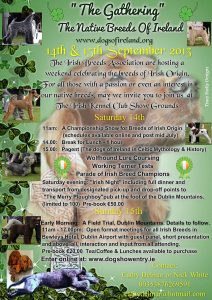 “We built up a portfolio so we had something to show the government, not just an idea,” Delmar said. “We created a heritage weekend revolving around dogs. Even hawking with setters in the midland bogs. People learned a lot about Irish breeds. The general populace is now more aware.”
“We built up a portfolio so we had something to show the government, not just an idea,” Delmar said. “We created a heritage weekend revolving around dogs. Even hawking with setters in the midland bogs. People learned a lot about Irish breeds. The general populace is now more aware.”
The Irish Kennel Club was only the national body that made the application. So much enthusiasm and work done was from a handful of devoted fanciers, Delmar said.
“Dogs developed because of working ability originally,” Delmar observed. “Ireland has the Irish Wolfhound and Kerry Beagle, Red setter, Red and white setter and Water spaniel. In the terrier group we have Kerry Blue, Irish, Glen of Imaal, Soft Coated Wheaten.”
Purebred dogs are history and art
Wolfhounds are one of the ancient symbols of Ireland along with the shamrock and harp. Kerry beagle are a hunting pack unique to Ireland. During the potato famine in Ireland, ships carrying refugees to the US, took Kerry beagles with them. Delmar expects these dogs could be found behind coonhounds in the US.
Romantic figures in Irish history hunted on horseback with hawks and setters, using nets before guns were invented.
Delmar’s telling of the rich tapestry of Irish history, includes Grace O’Malley — one of the earliest known female pirates, born around 1530 in Ireland and growing up to lead a 20-ship fleet. Her contribution to the development of the Irish Water Spaniel was the connection to her incursions on the Iberian Peninsula.
“We just undersell everything we do,” Delmar said. “We don’t spend enough time telling people that what you get with pedigree dogs is predictable qualities, predictable characteristics. Don’t get that in crossbreds. Can be great dogs. They might have one or two of the qualities. But it’s a lucky get. Like Forrest Gump’s box of chocolates.”








